Optogenetics Equipment and Custom Solutions

- Custom Optogenetics Equipment
- Next-Day Availability
CFM12L10
CFMLC12L05
Fiber Optic
Implantable Cannula
M470F1
LED Light Source
FJPFF2
Rotary Joint Patch Cable
ADAF2
Quick-Release
Interconnect
XCF
Cannula Holder for Ø2.5 mm Ferrules

Please Wait
Thorlabs Optogenetics Equipment
- Thorlabs' Optogenetics Equipment is used Extensively in Leading Optogenetics Labs
- Custom Optogenetics Equipment Built to Order
- Complete System Including Fiber Optic Cannulae, Fiber Patch Cables, and Light Sources
- Stock Components (Same Day Shipping)
- Fiber Optic Cannulae
- Stereotaxic Cannula Holders and Adapter Arms
- Cannula Implant Guides
- Fiber Optic Patch Cables
- Rotary Joint Fiber Optic Patch Cables
- Lightweight Patch Cables
- Rotary Joint
- Fiber Optic Interconnect and Mating Sleeves
- Fiber Optic Couplers/Splitters and Wideband Multimode Circulators (WMC)
- Rotary Joint Splitters
- LED and Laser Light Sources
- Complete Optogenetics Kits
- Next-Day Availability for Custom Patch Cable Orders Placed Before 2 PM EST
Thorlabs offers a full line of optogenetics equipment for in vivo stimulation, including implantable fiber optic cannulae, fiber optic patch cables and rotary joints, and LED and laser light sources. We are also well equipped to provide custom optogenetics packages including fiber-coupled light sources and custom-made cannulae. Please contact Tech Support for individual assistance regarding optogenetics equipment selection.
Interactive Optogenetics System Schematic
Click on the components or labels for more details about our optogenetics line of products. Contact Tech Support for more information about our expanding line of optogenetics products.

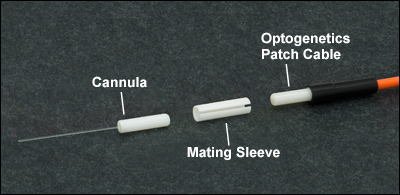
Click for Details
Ferrule Patch Cables are ideal for connection to our Implantable Fiber Optic Cannulae.

Click to Enlarge
Thorlabs' Dual-Core Fiber Optic Patch Cable and Dual-Core Implantable Cannula enable light at different wavelengths to be inserted in close proximity.
Fiber Optic Cannulae
- Low-Profile Implantable Fiber Optic Cannulae
- Ø1.25 mm and Ø2.5 mm Ceramic and Stainless Steel Ferrules Available
- Ø200 µm, Ø300 µm, and Ø400 µm Multimode Optical Fiber Available
- Precision-Cleaved or Scissor-Cut Fiber End
- Custom Cannula Also Available (see the Custom Cannula Tab)
Thorlabs offers stock and custom fiber optic cannulae, which can be surgically mounted to the skull of the specimen using stereotactic guidance. Custom cannulae are available with a stainless steel or ceramic ferrules as well as an array of different fiber types, lengths, and end terminations. See the Custom Cannula tab above for details.
| Fiber Optic Cannula Selection Guide | |||||
|---|---|---|---|---|---|
| Ferrule Size | Single Core | Dual Core | Empty Ferrule | ||
| Ø1.25 mm | Stainless Steel | Ceramic | Uncleaved Fiber End |
- | Ceramic |
| Ø2.5 mm | Stainless Steel | Ceramic | Stainless Steel | ||
Two Methods of Use
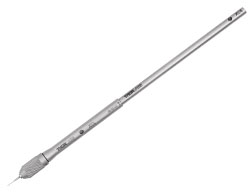
Click to Enlarge
The cannula holder can be attached directly to an adapter arm by using the left-handed 8-32 tap at the end of the cannula holder.
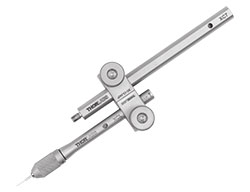
Click to Enlarge
Alternatively, the XC-CLAMP can be used to allow for coarse height adjustment between the cannula holder and the XC7 adapter arm.
Stereotaxic Cannula Holders and Adapter Arms
- Cannula Holders Secure Ø1.25 mm or Ø2.5 mm Fiber Optic Cannulae During Implantation
- Requires Less Force to Use than Competing Solutions, Reducing Stress on the Specimen
- Ø5 mm and Ø7.9 mm Adapter Arms Provide Compatibility with Most Stereotaxic Equipment
- Adapter Clamp for Coarse Height Adjustment of Cannula Holder
- Stainless Steel Construction for Easy Sterilization
Thorlabs' Cannula Holders and Adapters are designed to securely hold a fiber optic cannula during implantation using a stereotaxic apparatus. For easy sterilization and repeated use, these holders and adapters are manufactured using stainless steel. The cannula holders feature an easy-to-use chuck that minimizes the stress on the specimen during implantation and when releasing the cannulae. For compatibility with most standard stereotaxic equipment, the cannula holders contain 8-32 threads that can accept our Ø5 mm and Ø7.9 mm adapter arms. Additionally, the cannula holders and adapter arms can also be used with the adapter clamp sold below, which provides coarse height adjustment of a cannula holder and Ø7.9 mm adapter arm via two 1/4"-20 thumbscrews.

Click for Details
Implant Guide Assembly

Click to Enlarge
Weep holes for epoxy to escape
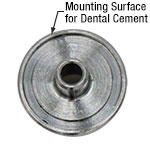
Click to Enlarge
Mounting Surface of OGF Cannula Impant Guide
Cannula Implant Guides
- Improves Adhesion and Stability During Implantation
- Compatible with Ø1.25 mm and Ø2.5 mm Fiber Optic Cannulae with ≥5 mm Length
- Ø3.8 mm (OGL) or Ø5.1 mm (OGF) Mounting Surface with Grooved Ring for Dental Cement
- Lightweight Surgical Titanium Construction (≤0.11 g)
- Weep Holes for Glue and Epoxy to Secure a Cannula
- Compatible with Stereotaxic Cannula Holders
These Cannula Implant Guides are designed to provide guidance and stability for a fiber optic cannula during an implantation procedure. The bottom surface of each implant guide features a roughened surface and circular groove (see image to the right) that increase the surface area available to dental cement and improves adhesion to the specimen. A 1.6 mm long protrusion on the implant guide helps stabilize the guide when implanted. Each implant is constructed using lightweight surgical titanium (≤0.11 g) which can be sterilized prior to use.
For best results when implanting a cannula, the OGL and OGF should be used with a cannula holder and stereotaxic guidance equipment. To affix the cannula within the implant guide, first insert the cannula into the receptacle of the implant guide. Then, add a small amount of cement or epoxy to the cannula via the two Ø0.8 mm weep holes (see image above). Finally, attach the cannula ferrule to an XCL (Ø1.25 mm ferrule) or XCF (Ø2.5 mm ferrule) cannula holder (see image above).
The OGL implant guide is compatible with our standard Ø1.25 mm cannulae (ceramic and stainless steel) and the OGF implant guide is compatible with our standard Ø2.5 mm cannulae (ceramic and stainless steel). When assembled, the length of the protruding fiber is reduced by 1 mm (Item # OGL) or 2 mm (Item # OGF); therefore, these implant guides cannot be used with our 2 mm long cannulae. Additionally, due to the fiber separation distance, the implant guides cannot be used with our dual-core cannulae.
| Optogenetics Patch Cables Selection Guide | ||||
|---|---|---|---|---|
| Ferrule Size | Single Core | Dual Core | ||
| Ø1.25 mm | FC/PC | SMA | - | |
| Ø2.5 mm | FC/PC | SMA | FC/PC and SMA | |
Fiber Patch Cables
Fiber Optic Rotary Joint Patch Cables
- Articulated Rotary Joint Prevents Fiber Damage Caused by Moving Specimen
- Integrated Ø200 µm or Ø400 µm Core Fiber Patch Cables
- Stainless Steel Armor on Specimen Side Available for Ø200 µm Patch Cables with Ø2.5 mm Ferrule Ends
- Single Cable Connects Cannula and Light Source in Optogenetics Experiments
- Extremely Smooth Rotation
- SM05-Threaded Housing for Secure Mounting
Our articulated fiber optic patch cables feature a rotary joint interface that allows the cable to freely rotate, reducing damage in optogenetics experiments. They provide a complete solution for connecting the light source to an implanted fiber optic cannula and are compatible with all Thorlabs light sources and optogenetics equipment.
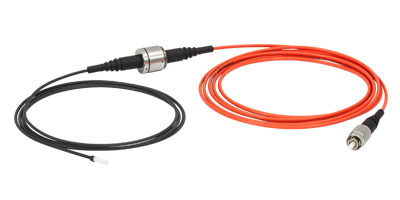
Click to Enlarge
RJPFF2 Rotary Joint Patch Cable
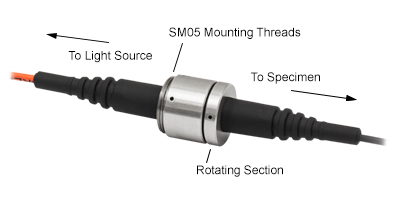
Click to Enlarge
Rotary Joint Detail
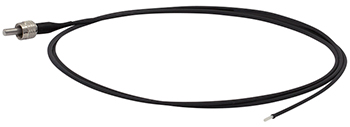
Click to Enlarge
Ø1.25 mm Ferrule Optogenetics Patch Cable
Standard Lightweight Fiber Optic Patch Cables
- Large Selection of Multimode Fiber Patch Cables Ideal for Optogenetics
- Cables are Compatible with Ø1.25 mm and Ø2.5 mm Ferrule Cannulae
- Cables are Lightweight and Flexible for Specimen Mobility
Our optogenetics patch cables can be used to connect a light source to a fiber optic implantable cannulae. We offer small diameter fiber that minimizes tissue damage, as well as extra lightweight cables for Ø1.25 mm cannulae.
Specialty Fiber Patch Cables
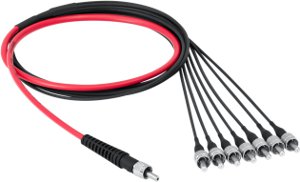
Click to Enlarge
Custom 7 to 1 Fan Out Cable
- Extensive Custom Cable Capabilities and In-House Fiber Manufacturing
- Examples of Custom Optogenetics Cables Include:
- 7 to 1 Fan-Out Cable for Incorporating Multiple Light Sources into a Single Probe
- Stainless Steel Armored Cable for Protection from Specimen Damage
- See the Custom Cables Tab Above, or Contact Tech Support to Order a Custom Cable
We can custom fabricate cables, including armored cable for protection from specimen damage and fan out cables for incorporating multiple light sources into one fiber optic implant. See the Custom Cables tab above for details.
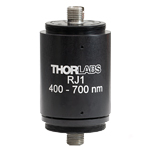
Click to Enlarge
The RJ1 rotary joint has terminated ends and accepts a wide variety of FC/PC patch cables.
1x1 Rotary Joint for FC/PC Multimode Patch Cables
- Rotary Joint Protects Against Fiber Damage Caused by Moving Specimen
- Consistent Performance Over 400 - 700 nm Wavelength Range
- Low Transmission Variation During Rotation
- Recommended for ≥Ø200 µm Core, 0.22 to 0.50 NA Patch Cables
- Tested and Designed for Use with a Multimode Laser or Fiber-Coupled LED
Thorlabs' RJ1 1x1 Rotary Joint for FC/PC Multimode Patch Cables is a single input and output rotary joint with low rotational variation. Designed for use in optogenetics, the rotary interface allows patch cables to rotate freely when attached to a moving specimen, reducing the risk of both fiber damage and intensity fluctuations. The input and output patch cables are not permanently attached to the rotary joint, and, as a result, can be selected with a specific core size, NA, and jacketing type to optomize an experiment. This also allows cables to be easily replaced if fibers are damaged. For best performance, we recommend using multimode fibers with a core diameter ≥Ø200 µm and NA between 0.22 to 0.50. Thorlabs can provide custom rotary joints that are aligned and optimized using other patch cables or light sources; please contact Tech Support with inquiries.
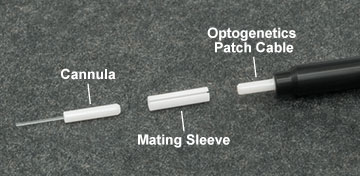
Click for Details
The ADAL1 Mating Sleeve is designed to mate Ø1.25 mm ferrule cannulae and patch cables.
Interconnect and Mating Sleeves
- Ceramic Mating Sleeves for Ø1.25 mm or Ø2.5 mm Bare Ferrules (Sold Individually or in Packs of 5)
- Quick-Release Interconnect for Mating Ø1.25 mm or Ø2.5 mm Ferrule Patch Cables to Cannulae
- Compatible with Stainless Steel and Ceramic (Zirconia) Ferrules
Thorlabs offers interconnects and mating sleeves for making connections between our line of optogenetics patch cables and fiber optic cannulae. These ferrule mating components provide low-loss coupling and are compatible with both stainless steel and ceramic (zirconia) ferrules. Interconnects are designed to facilitate easy connections and disconnections from an implanted cannula, requiring >80% less force to disconnect compared to mating sleeves. On the other hand, mating sleeves are preferred for very lightweight (~0.18 g), low-profile connections between a patch cable and cannula.
Fused Fiber Optic Couplers / Splitters and Wideband Multimode Circulators / Combiners
Thorlabs multimode fiber couplers are optimized for optogenetics applications such as bilateral stimulation, where one light source is used to illuminate two fiber optic implants placed close together in the specimen. Couplers are available from stock with 1x2 and 2x2 configurations. Our couplers have SMA905 or FC/PC connectors on the input legs for compatibility with fiber-coupled LED and laser light sources. They are available with Ø2.5 mm ferrule ends on the output legs for direct connection to a fiber optic cannula, or with standard SMA905 or FC/PC connectors for use with other patch cables, such as our rotary joint cables featured above.
Thorlabs also offers wideband multimode circulators (WMC), which can be used to combine different wavelength light sources into a single output with greater throughput than a 2x2 coupler (see diagram to the right below). They can also be used as a circulator, enabling high efficiency transfer from port 1 to port 2 as well as bidirectional multimode transmission between port 2 and port 3. These fused fiber WMCs are available with SMA905 or FC/PC connectors for compatibility with fiber-coupled LED and laser light sources.
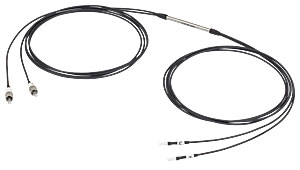
Click to Enlarge
2x2 Multimode Fiber Coupler

WMCs in series can combine multiple light sources by injecting them into port 1 (blue). Any signal returned through port 2 (white) will exit port 3 (red).
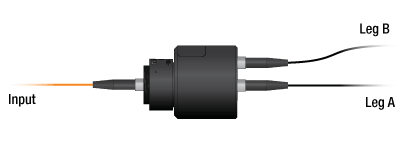
Click to Enlarge
Schematic illustrates the input and output ports of the RJ2 1x2 rotary joint.
Rotary Joint Splitter
- Rotary Joint Protects Against Fiber Damage Caused by Moving Specimen
- 400 – 700 nm Wavelength Range
- 50:50 Intensity Split of Input Light
- Low Transmission Variation During Rotation
- Recommended for ≥Ø200 µm Core, 0.22 to 0.50 NA Patch Cables
- Tested and Designed for Use with a Multimode Laser or Fiber-Coupled LED
Thorlabs' RJ2 1x2 Rotary Joint Splitter is designed for optogenetics applications and is used to split light from a single input evenly between two outputs. The rotary joint interface allows connected patch cables to freely rotate, reducing the risk of fiber damage caused by a moving specimen. The rotary joint accepts any FC/PC-terminated patch cable, such as our optogenetics, multimode, and hybrid patch cables. For best performance, we recommend using multimode patch cables with a TECS-clad fiber, core diameter ≥Ø200 µm, and NA between 0.22 to 0.50. Thorlabs can provide custom rotary joint splitters that are aligned and optimized using other patch cables or light sources; please contact Tech Support with inquiries.
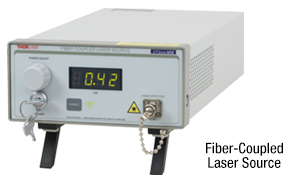
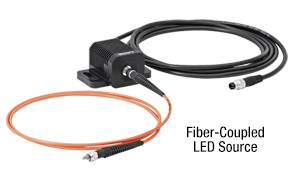
Light Sources
Thorlabs offers a variety of fiber-coupled light sources that can be used for in vivo stimulation. Our Fiber-Coupled LEDs offer a durable, economic solution with a variety of wavelength choices. Our Fiber-Coupled Lasers, Pigtailed Laser Diodes, and Benchtop Laser Diodes provide higher power at the cannula tip, and our Multichannel Light Source and Chrolis™ Light Source offer a variety of wavelengths in compact units.
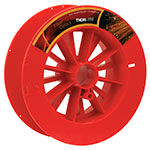
Click to Enlarge
Multimode Optical Fiber
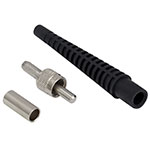
Click to Enlarge
SMA Connector Components
Cable and Cannula Building Supplies
- Bare Optical Fiber, Ferrules, Tubing, Connectors, and Tools
- Build Custom Cannulae and Fiber Optic Patch Cables
- Connectorization Kit Provides all Necessary Tools
- Complete Connectorization Instructions Available for Download
Thorlabs stocks individual components for building custom fiber optic cannulae and patch cables, including optical fiber, ferrules, connectors, tubing, and connectorization tools. Our FN96A connectorization manual, which is free to download, gives clear instructions on how to add connectors to optical fiber.
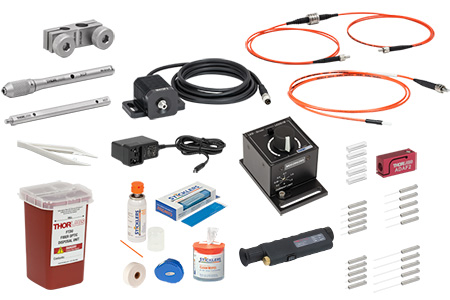
Click for Details
Example Kit with Ø400 µm Core Fiber, Ø2.5 mm Ferrules, and Rotary Joint Patch Cable
Customizable Optogenetics Kits
- Complete Fiber Optics Setup
- Substitute or Remove Items for Tailored Use
- LED, Patch Cable, Cannulae, and Accessories
- Ferrule Options:
- Ø1.25 mm Ferrules (Ø200 or Ø400 µm Core)
- Ø2.5 mm Ferrules (Ø200 or Ø400 µm Core)
- Patch Cable Options
- Standard Lightweight Patch Cable, 1 m Long
- Patch Cable with Integrated Rotary Joint, 3 m Long
- Multiple Lengths of Cleaved Cannulae
- Certain Kits Include Uncleaved Cannulae and Cleaving Tools
- Cannula Holders for Stereotaxic Implantation
- Cleaning Supplies
Thorlabs' optogenetics equipment is available in complete, ready-to-use kits. These optogenetics kits are comprised of essential supplies to establish and maintain optogenetics experiments; kit contents may be substituted or removed to suit individual needs. Each kit includes a 470 nm Fiber-Coupled LED with driver, lightweight patch cables, interconnect and mating sleeves, cannulae, and fiber handling and maintenance tools. We offer kits with Ø200 µm or Ø400 µm fiber components and Ø1.25 mm or Ø2.5 mm ferrules.
For information concerning custom orders, pricing, and availability, please contact Tech Support.

Custom Fiber Optic Cannula
Thorlabs offers custom cannulae with the following options. Place a quote request through the following form to receive a quote for your custom cannula order.
| Posted Comments: | |
| No Comments Posted |
| Quick Links | |||
|---|---|---|---|
| Single-Site Stimulation | |||
| One Light Source to One Cannula Implant | |||
| Multilateral Stimulation | |||
| One Light Source to Two Cannula Implants Using Rotary Joint Splitter | |||
| One or Two Light Sources to Two Cannula Implants | |||
| One Light Source to Seven Cannula Implants | |||
| Two Light Sources into One Dual-Core Cannula Implant | |||
| Illumination | |||
| Fiber-Coupled LEDs and Drivers | |||
Optogenetics Selection Guide
Thorlabs offers a wide range of optogenetics components; the compatibility of these products in select standard configurations is discussed in detail here. Please contact Technical Support for assistance with items outside the scope of this guide, including custom fiber components for optogenetics.
Single-Site Stimulation
One Light Source to One Cannula Implant
The most straightforward method for in vivo light stimulation of a specimen is to use a single fiber optic with a single LED light source. The single wavelength LED is powered by an LED driver, and then the illumination output is fiber-coupled into a patch cable, which connects to the implanted cannula. See the graphics and expandable compatibility tables below for the necessary patch cables and cannulae to create this setup. To choose the appropriate LED and driver, see below or the full web presentation.
Click on Each Component for More Information

Click to See Ø1.25 mm (LC) Ferrule Compatible Patch Cables, Cannulae, and Interconnects
Click to See Ø2.5 mm (FC) Ferrule Compatible Patch Cables, Cannulae, and Interconnects
Multilateral Stimulation
The ability to accurately and simultaneously direct light to multiple locations within a specimen is desired for many types of optogenetics experiments. For example, bilateral stimulation techniques typically target neurons in two spatially separated regions in order to induce a desired behavior. In more complex experiments involving the simultaneous inhibition and stimulation of neurons, delivering light of two different monochromatic wavelengths within close proximity enables the user to perform these experiments without implanting multiple cannulae, which can increase stress on the specimen.
Multilateral stimulation can be achieved with several different configurations depending on the application requirements. The sections below illustrate examples of different configurations using Thorlabs' optogenetics products.
Option 1: One Light Source to Two Cannula Implants Using Rotary Joint Splitter
Thorlabs' RJ2 1x2 Rotary Joint Splitter is designed for optogenetics applications and is used to split light from a single input evenly between two outputs. The rotary joint interface allows connected patch cables to freely rotate, reducing the risk of fiber damage caused by a moving specimen. See the graphic and compatibility table below for the necessary cables and cannulae to create this setup. For LEDs and drivers, see below or the full web presentation.

Click to See Ø1.25 mm (LC) Ferrule Components Recommended for Use with RJ2 Rotary Joint Splitter
Click to See Ø2.5 mm (FC) Ferrule Components Recommended for Use with RJ2 Rotary Joint Splitter
Option 2: One or Two Light Sources to Two Cannula Implants
If the intent is for one LED source to connect to two cannulae for simultaneous light modulation, then a bifurcated fiber bundle can be used to split the light from the LED into each respective cannula. For dual wavelength stimulation (mixing two wavelengths in a single cannula) or a more controlled split ratio between cannula, one can use a multimode coupler to connect one or two LEDs to the cannulae. If one cable end is left unused, the spare coupler cable end may be terminated by a light trap. See the graphic and compatibility table below for the necessary cables and cannulae to create this setup. For LEDs and drivers, see below or the full web presentation.
Click on Each Component Below for More Information

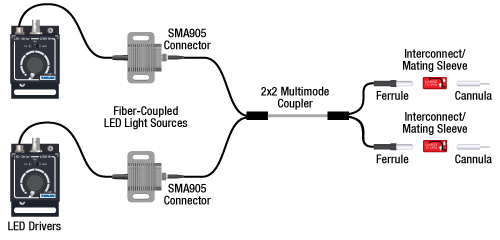
Option 3: One Light Sources to Seven Cannula Implants
If the intent is for one LED source to connect to seven cannulae for simultaneous light modulation, then a 1-to-7 fiber bundle can be used to split the light from the LED into each respective cannula. See the graphic and compatibility table below for the necessary cables and cannulae to create this setup. For LEDs and drivers, see below or the full web presentation.
Click on Each Component Below for More Information
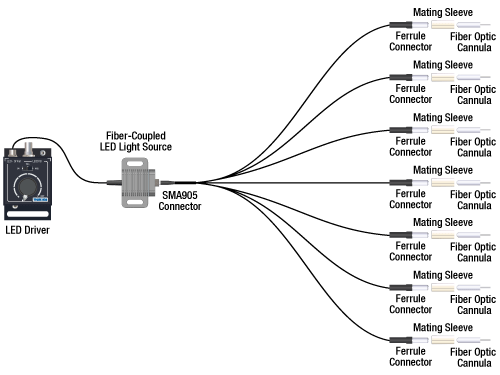
Two Light Sources into One Dual-Core Cannula Implant
For bilateral stimulation applications where the two cannulas need to be placed in close proximity (within ~1 mm), Thorlabs offers dual-core patch cables and cannulae that are designed for this specific application. Each core is driven by a separate light source, enabling users to stimulate and/or supress nerve cells in the same region of the specimen. See the graphic and compatibility table below for the necessary cables and cannulae to create this setup. For LEDs and drivers, see below or the full web presentation.
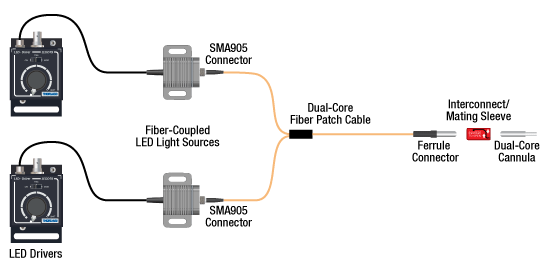
Click on Each Component for More Information
| Part Selection Table (Click Links for Item Description Popup) | |||||||||
|---|---|---|---|---|---|---|---|---|---|
| Common Fiber Properties | |||||||||
| Core Diameter | 200 µm | ||||||||
| Wavelength Range | 400 - 2200 nm | ||||||||
| NA | 0.39 | ||||||||
| Fiber Type | FT200EMT | ||||||||
| Ferrule Stylea | FC (Ø2.5 mm) | ||||||||
| Dual-Core Patch Cable | FC/PC Input | BFY32FL1 | |||||||
| SMA905 Input | BFY32SL1 | ||||||||
| Compatible Mating Sleeve/Interconnect | ADAF1 ADAF2 ADAF4-5 |
||||||||
| Dual-Core Fiber Optic Cannulaec | Stainless Steel | CFM32L10 CFM32L20 |
|||||||
| LED Item # | Wavelengtha | Typical Opsin | Output Powerb | Color |
|---|---|---|---|---|
| M385F1c | 385 nm | EBFP, moxBFP | 10.7 mW | UV |
| M405F1c | 405 nm | mmilCFP, hcriGFP | 3.7 mW | UV |
| M430F1 | 430 nm | ChR2 | 7.5 mW | Violet |
| M455F3 | 455 nm | ChIEF, bPAC | 24.5 mW | Royal Blue |
| M505F3 | 505 nm | ChRGR, Opto-α1AR, Opto-β2AR | 11.7 mW | Cyan |
| M530F2 | 530 nm | C1V1, VChR1 | 9.6 mW | Green |
| M565F3 | 565 nm | Arch, VChR1-SFO | 13.5 mW | Lime |
| M595F2 | 595 nm | ChR2-SFO, eNpHR3.0 | 11.5 mW | Amber |
| M625F2 | 625 nm | ReChR | 17.5 mW | Red |
Illumination
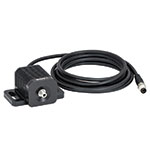
Click to Enlarge
M405F1
Fiber-Coupled LEDs and Drivers
Our fiber-coupled LEDs are ideal light sources for optogenetics applications. They feature a variety of wavelength choices and a convenient interconnection to optogenetics patch cables. Thorlabs offers fiber-coupled LEDs with nominal wavelengths ranging from 280 nm to 1050 nm. See the table to the right for the LEDs with the most popular wavelengths for optogenetics. A table of compatible LED drivers can be viewed by clicking below.
 Products Home
Products Home










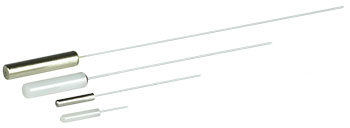
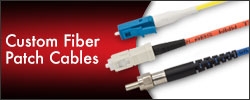


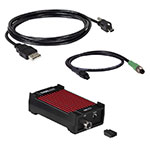
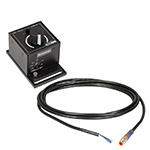
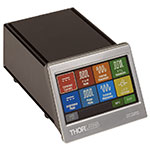
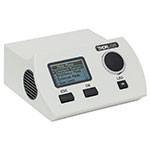
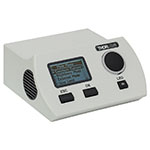

 Optogenetics Overview
Optogenetics Overview